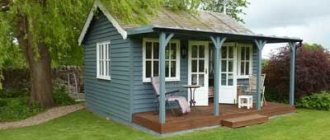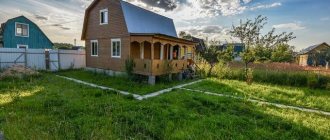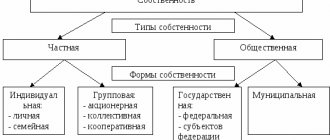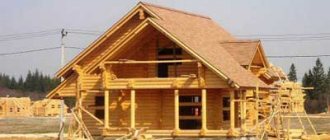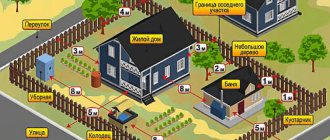Categories
For 2021, there are 2 types of permitted plots for the construction of buildings:
- settlements (ZNP);
- agricultural purposes (Agriculture).
ZNP represent territories within which real estate development of settlements (cities, villages, etc.) is carried out.
Agricultural farming is plots intended for raising livestock, growing crops, beekeeping, etc.
You can build a house on these 2 types of territories if the conditions for permitted use are met (more on this below). On other lands under the control of the Ministry of Environmental Protection (reserves, rivers, lakes, forestry and others), the armed forces (reserve lands), and industrial facilities, the construction of buildings is prohibited.
Where you can build and where you can’t Source deltodom.ru
However, in some situations it is possible to obtain a plot in such territories if you change its purpose to conditionally permitted. Everything is clarified locally.
Regarding the construction of a house on a specific site within the boundaries of the ZNP or ZA, here you will need to clarify in which area the building can be erected. For this purpose, a classifier of types of permitted use of territorial allotments (VRI) is provided.
What is the difference between the latter and ZNP or ZSH? The fact is that the VRI is a specific clarification of the encumbrances of the site. For example, the area may be intended strictly for raising livestock: pigs, cows or horses.
VRI ZNP
The RFP provides for the following VRI:
- Low-rise building . This term refers to plots allocated for individual housing construction, the construction of a country house along with storage rooms, a garage and other outbuildings. 3-story single-family houses are allowed.
What can be built on land for individual housing construction Source superrielt.ru
- Territory for “nomads” : intended for setting up tent cities, trailers, trailers.
- Allotment of personal subsidiary plot (LPH) . In addition to a low-rise building, buildings for keeping animals are allowed here: a barn, a cowshed, stables, a personal plot.
- Townhouse (building blocked on 2 sides) . It consists of houses built in a row, close to each other.
- Territory for mid-rise buildings, skyscrapers . On such lands you can build buildings higher than 3 levels.
- Area for servicing residential areas . The construction of catering buildings, shopping centers, educational institutions and much more is allowed.
Using different types of plots Source nazemle.club
On which plot you can build a house and register, if it is in the ZNP, depends on the type of planned construction.
The following VRIs are intended for permanent buildings with the possibility of registration:
- low-rise;
- blocked;
- LPH.
In the case of a mobile building on wheels or skids, it can be located on any privately owned property or on “mobile” lands.
VRI ZSKH
These lands must be used in connection with the work associated with agriculture: growing plants to provide food.
If you turn to the VRI ZSH classifier, they are divided into 2 categories:
- on which it is possible to build capital structures for individual housing construction. (code 1.16, 13.1-13.3.);
- on which houses cannot be built. (code 1.0-1.15, 1.17, 1.18)
What types of sites belong to codes 1.16, 13.1-13.3? These are land plots intended:
- For private household plots: breeding birds, livestock. It is allowed to erect temporary buildings without a foundation here.
- For carrying out gardening and gardening work. You can build houses for seasonal living. However, permission to build housing is not required. You can also build permanent buildings.
In what case is the court?
Some will ask: “Can I register at the dacha?
And in what case will it be necessary to go to court? In any case, you can register at your dacha only through the court .
This is due to the fact that the situation is not standard, but requires a special approach.
An exception may arise when the owner, for some reason, has already converted the dacha building into a residential building .
That is why in the vast majority of cases there is no way to get by without going to court.
Video description
The video shows how to build a house on agricultural land:
On a note! In which area you can register, if they belong to the agricultural sector, we look at Federal Law No. 217-FZ, which states that registration at the place of residence is allowed in dacha areas.
If the land is located on an area intended for agricultural use: haymaking, arable land, then you cannot build a house on it. Since this is prohibited by law No. 101-FZ. In case of unauthorized construction, the defendant faces a fine of at least 3 thousand rubles.
There is also a ban on capital construction of residential buildings on agricultural land, which, according to their intended purpose, include:
- To grow crops . You can only place mobile places of residence: trailers, etc.
- Research laboratories in the field of agriculture . The law provides for the placement of utility rooms here for exclusively scientific purposes.
- Fish farming . Placement of artificial ponds is required.
- Raising livestock or producing animal feed. Buildings for housing livestock are permitted.
- Nurseries for growing crop seedlings.
- Agro-industrial complexes for processing agricultural products and bringing them to the consumer. Warehouses, workshops and other production facilities for storing and processing goods are permitted.
- To enterprises that serve the agro-industrial complex . Buildings for equipment storage are permitted here.
- Beekeeping . By law, honey collection sites and the hives themselves must be located on the territory of the apiary.
In some cases, land should be used exclusively for agricultural needs Source vseon.com
See also: Catalog of the most popular plots in the Moscow region for the construction of suburban real estate.
Summer cottage or garden plots may be classified as ZNP. To find out which category a territory belongs to, you need to look at the cadastral number of the land.
It should also be borne in mind that all VRI agricultural agricultural enterprises can be divided into the following types:
- basic;
- conditionally permitted.
- serving.
The first VRIs are installed in strict accordance with the classifier. The second ones can be issued by district or city authorities to a specific owner in accordance with the PZZ.
What plot of land can I register on? Practice shows that at the main VRIs, which relate to private household plots, dacha and garden associations. Also for conditionally permitted ones - for example, when running a peasant farm, if you prove the absence of another place of residence in court.
On a note! The same site may have several VRIs, depending on the location. That is, it can relate to private household plots and private housing construction.
On what lands can you build a house Source ravely.rumebas.ru.net
How to register?
Step-by-step instruction
If the house is not yet included in the state register
The following is required:
- Contact the BTI to have cadastral work carried out.
- After contacting the BTI, a cadastral engineer will come to you. He will take measurements of the residential building and draw up a technical plan. According to the latest changes to the law, it must be compiled electronically and contain an electronic signature of the cadastral engineer. 14 days are allotted for carrying out the work and drawing up a report.
- Payment of state duty (350 rubles for each registered property). Details for depositing funds can be obtained from the registration authority where the documents will be submitted:
- Payment receipt included.
- Application for registration of residential real estate.
- Passport.
- Technical plan.
- Title documents for the site.
- Submitting a package of documents to Rosreestr. The state registration service can be submitted electronically, through State Services, by submitting an application for registration of a country house. If there are no errors, the data is entered into the registry.
- Obtaining an extract from the Unified State Register of Real Estate confirming ownership of the registered property.
The certificate is not issued in electronic form or in hand, as it is now stored in the archives of Rosreestr. Owners of country houses, dachas and garden plots who have registered their property are provided with an extract that is not inferior in legality to a paper certificate.
If the building is on the register
If the house is registered, then you can skip the previous stage and immediately contact the local authorities for permission. You need to write a petition to assign the building residential status.
To do this you need to provide:
- Application for registration.
- Passport.
- Certificate of ownership.
A construction inspection, document analysis, fire and sanitary control will be carried out (read more about what documents are needed for registration in a private house and how to quickly register here). The application is subject to consideration within a month, after which the applicant will be issued a certificate of assignment of residential status to the house or a reasoned refusal.
If you receive a refusal, you can:
- Correct all deficiencies and re-apply.
- File a claim in court and challenge the decision.
You can find out more about how to register in a private house and what you need for this in this article.
Going to court
In order for a building to be recognized as residential, a claim is filed with the district court, accompanied by a passport and title documents. In this case, a state fee of 200 rubles is paid. for individuals. The court is given a month to consider the application , during which a hearing date will be set.
During the case, a forensic examination is carried out, based on the results of which a conclusion is made whether the house meets sanitary requirements.
Obtaining court permission
After receiving court permission to transfer the house to housing stock, you can begin the standard registration procedure.
Where to apply for registration?
Since 2004, a special state body for migration, the Federal Migration Service, has been dealing with issues of registration of citizens . The procedure for registering citizens was carried out in accordance with the document issued by this organization - the Administrative Regulations.
Since 2021, the FMS has been abolished and issues related to migration have been transferred to the Ministry of Internal Affairs, within which a special department has been created (GUVM MIA). Documents can also be submitted through the MFC or submit an application on the State Services portal.
What documents are required?
When applying, you should have the following package of documents with you::
- a completed registration request form (you can pick it up on site);
- passport;
- extract from the Unified State Register of Real Estate;
- expert opinion and an act from the administration recognizing the house as residential.
Is it possible to build a house on country land?
Legislatively, on a dacha plot of land, as it turned out, it is possible to build buildings for living.
Such associations include:
- SNT – gardening non-profit partnership;
- SNK – horticultural cooperative;
- SNP - horticultural partnership.
According to the new law, you can register, that is, obtain a residence permit, in these buildings if they meet all the requirements for a permanent building and are fireproof.
You can build any house on dacha acres. But register only if the house meets the requirements for permanent residence: construction standards for the construction of permanent buildings, and also if all utilities are connected.
A house with a foundation will require a permit for its construction.
On dacha plots, standards must be met for the location of the house away from roads and boundaries with neighboring plots, if the house is built of wood.
Putting a building into operation is easier for dacha lands than for plots for individual housing construction. Registration in the real estate register also does not cause problems. However, these rules for registering housing are valid only until 2021. After this date, new standards for registration of constructed buildings will be introduced.
How to use your right as a land owner Source grazdaninu.ru
Terms and cost of registration
Having started the process of registering in a country house, you need to understand that the registration will take at least 1-1.5 months, provided that you are not subject to any checks. If somewhere not everything meets the standards and it is necessary to eliminate shortcomings, then registration may take an indefinite period of time.
In financial terms, the entire procedure will cost approximately 15-20 thousand rubles . Since you will have to pay for all the examinations and visits of specialists yourself.
Differences between areas: advantages and disadvantages
To figure out which plot is best to buy and where, you need to weigh all the pros and cons of each type of VRI for building a house.
individual housing construction
If a house is required for permanent residence registration, the priority is to purchase a plot within city or village boundaries.
Such plots differ in that the construction of a house will require a building permit with approval of boundaries. The buyer of such a plot is limited by the urban plan and development plans.
Note! The obvious advantage of this type of land is that there will be no problems with registration in the constructed house. Taxes are much lower than similar areas of garden associations.
In a house built for individual housing construction, the advantage will be that the house will receive its own postal address, which will make it possible to subsequently assign it a number in the state register and register ownership. Here you can also connect all communications: central water supply, sewerage.
Disadvantages of such a purchase: high cost of the plot and high property taxes.
Agricultural land
A certain category of land has agricultural status. But what is it? Agricultural land – as the name implies, those lands where only agricultural activities are allowed.
Agricultural land can be used for purposes such as:
- farming activities;
- dacha farming;
- gardening;
- livestock farming;
- gardening, etc.
In this plan for the use of agricultural land, agricultural land is divided into:
- land for agricultural work;
- plots of personal subsidiary plots.
The possible type of use is indicated directly in the cadastral documentation of the site. The first category of land for agricultural production is allocated only for commercial activities to farms and sometimes for the work of research centers.
Ordinary citizens can only receive land from the agricultural category for running a personal subsidiary plot or for running a dacha farm.
But this does not mean that the owners of such land do not have the right to make a profit from the use of the site. Products obtained from private household plots can also be sold.
On the other hand, the agricultural status of the land limits the rights of citizens to use these plots. Thus, these plots cannot be used for housing construction.
Video description
You can clearly see the categories of land plots and permitted uses in the following video:
Garden community
SNT has a VRI for growing garden crops. Located in the ZA, although some of them may belong to the ZNP, according to legislative acts as a result of the expansion of the territory of the city or town.
Pros of SNT:
- there is the possibility of constructing permanent residential buildings and auxiliary premises;
- low cost of land compared to individual housing construction;
- The territory is located far from cities, in an ecologically clean area.
- it is possible to register at the place of residence in accordance with new amendments to the legislation.
Minuses:
- additional costs for supplying electricity, water, and installing a sewer system;
- impossibility of purchasing a plot of land on credit through a mortgage.
What is allowed for SNT Source viq.lebucos.ru.net
About the opportunity
Is it possible to register at a dacha in Russia? Today you can register at your dacha , but with a reservation .
This does not apply to all cases, and the decision is made on a case-by-case basis.
This means that there is such a possibility, but subject to certain conditions that the site itself and the building on it must meet.
This situation is due to the fact that the Constitutional Court of the Russian Federation recognized the ban on registering in such premises as a violation of the right of citizens to an independent and free choice of place of residence .
However, universal amendments to housing and civil legislation have not yet been made , so approvals are accepted only on an individual basis.
Find out on our website how many people can be registered at one address, as well as how the number of registered people will affect the rent.
Where you can't build a house
According to legal regulations, not all areas located in the field are suitable for construction.
It is prohibited to build houses on the coastline near rivers and lakes. In some cases, the exclusion zone can be 200 m. Any restriction of free access to the shore can be interpreted as a violation of the law and punishable by a fine and the demolition of the building itself.
Can and cannot be legitimized Source znamyuzl.ru
Judicial permission
There is a different scenario for carrying out registration than first obtaining judicial permission. You can contact the administration of the city (settlement) to which the dacha education belongs with a petition to recognize the building as residential .
There is a special commission that considers such issues. Then apply to the Main Department of Internal Affairs of the Ministry of Internal Affairs of the Russian Federation to obtain a residence permit, which will most likely be refused, since there is no court permission, and then challenge the refusal in court.
This scenario is usually used by those who have been refused by the registration authority and those who did not know that they could not do without a trial .
Additional questions
How to find out what can be built on a plot of land? To find the necessary information you need to use the public cadastral map. In the search block for a plot by cadastral number, you need to enter the appropriate values. The characteristics of the land plot will appear in the result window - category and its restrictions, VRI.
Using the information from this article, you will need to determine those types of land plots for building a house that are permitted by law and the VRI that is available, and compare the characteristics.
How to find out whether it is possible to build a house on a plot of land? To do this, you need to contact the head of the administration and the architect of the district if the site has already been purchased.
If the purchase is just planned, it is necessary to request an extract from the register of rights (USRE) with the owner of the land. You can obtain it from Rosreestr by paying the appropriate amount. It will indicate the existing restrictions on the site.
Required documents and procedure
To transfer SNT to individual housing construction, you will need some documents.
The list is different for plots of different status. The following will be required:
- garden book;
- description of the site and its boundaries;
- Regulations of the Administration on the allocation of plots;
- report of the general meeting of the partnership where the decision was made;
- extraction from the cadastral plan for the entire land plot owned by SNT;
- document confirming the allocation of the allotment.
If the garden plot is located within a populated area, the following package is provided:
- the applicant’s passport – a copy and the original, or a power of attorney if the application is submitted by another person;
- certificate of title to land;
- site map;
- extract from EGRN;
- territory development project.
In addition, if there is already a permanent building on the site, then documents are required confirming that the house belongs to the owner.
If SNT is located outside the boundaries of the settlement, re-registration is also possible. The document is submitted to the administration of the locality or district. If the SNT is located far from the village, the transition requires the applicant's passport, an extract from the EGRN and confirmation of the use of the grant.
Without cadastral registration, the application will not be considered.
Possible problems
The main difficulty is the intentions of the local administration . If its plans for the development of the territory are not combined with the transfer of land to another category, it is almost impossible to change the status.
There are other reasons :
- errors in paperwork, missing documents;
- submission of certificates and applications later than the accepted deadlines;
- presence of burdens;
- if only 1 partner of the partnership wants to make the transfer, the application will not be accepted.
A positive response takes about 3 months. A negative result is obtained faster – within 1 month.
